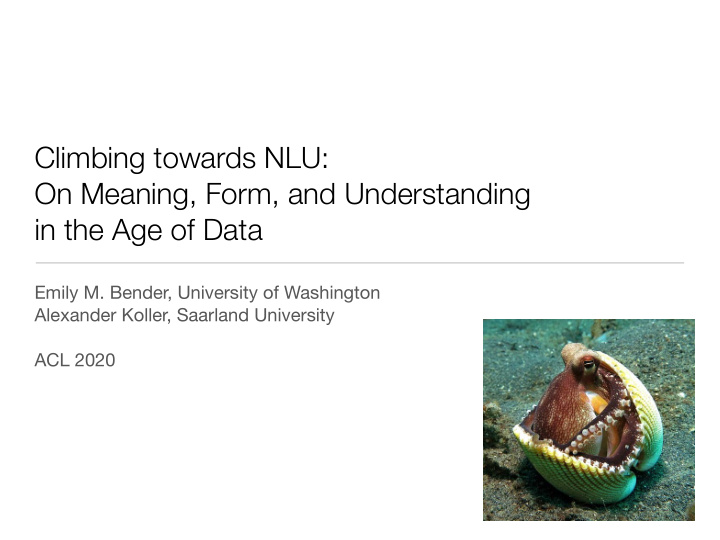



Climbing towards NLU: On Meaning, Form, and Understanding in the Age of Data Emily M. Bender, University of Washington Alexander Koller, Saarland University ACL 2020
This position paper talk in a nutshell • Human-analogous natural language understanding (NLU) is a grand challenge of AI • While large neural language models (LMs) are undoubtedly useful, they are not nearly-there solutions to this grand challenge • Despite how they are advertised • Any system trained only on linguistic form cannot in principle learn meaning • Genuine progress in our field depends on maintaining clarity around big picture notions such as meaning and understanding in task design and reporting of experimental results.
What is meaning? • Competent speakers easily conflate ‘form’ and ‘meaning’ because we can only rarely perceive one without the other • As language scientists & technologists, it’s critical that we take a closer look
<latexit sha1_base64="1aMEQp5k4fS9sg6Ro9oDmof9PTM=">ACAXicbVDJSgNBEO2JW4xb1IvgpTERPIWZXPQYFEPQgSzQGYIPZ2apEnPYneNEK8+CtePCji1b/w5t/YWQ6a+KDg8V4VfX8RAqNtv1tZaWV1bXsu5jc2t7Z387l5dx6niUOxjFXTZxqkiKCGAiU0EwUs9CU0/P7F2G8gNIiju5wkIAXsm4kAsEZGqmdPyjeUFenvgaEe3pJXRQhaHpdbOcLdsmegC4SZ0YKZIZqO/ldmKehAhl0zrlmMn6A2ZQsEljHJuqiFhvM+60DI0YmaPN5x8MKLHRunQIFamIqQT9fEkIVaD0LfdIYMe3reG4v/ea0UgzNvKIkRYj4dFGQSoxHcdBO0IBRzkwhHElzK2U95hiHE1oOROCM/yIqmXS45dcm7Lhcr5LI4sOSRH5IQ45JRUyBWpkhrh5JE8k1fyZj1ZL9a79TFtzVizmX3yB9bnD1UplYI=</latexit> <latexit sha1_base64="1aMEQp5k4fS9sg6Ro9oDmof9PTM=">ACAXicbVDJSgNBEO2JW4xb1IvgpTERPIWZXPQYFEPQgSzQGYIPZ2apEnPYneNEK8+CtePCji1b/w5t/YWQ6a+KDg8V4VfX8RAqNtv1tZaWV1bXsu5jc2t7Z387l5dx6niUOxjFXTZxqkiKCGAiU0EwUs9CU0/P7F2G8gNIiju5wkIAXsm4kAsEZGqmdPyjeUFenvgaEe3pJXRQhaHpdbOcLdsmegC4SZ0YKZIZqO/ldmKehAhl0zrlmMn6A2ZQsEljHJuqiFhvM+60DI0YmaPN5x8MKLHRunQIFamIqQT9fEkIVaD0LfdIYMe3reG4v/ea0UgzNvKIkRYj4dFGQSoxHcdBO0IBRzkwhHElzK2U95hiHE1oOROCM/yIqmXS45dcm7Lhcr5LI4sOSRH5IQ45JRUyBWpkhrh5JE8k1fyZj1ZL9a79TFtzVizmX3yB9bnD1UplYI=</latexit> <latexit sha1_base64="1aMEQp5k4fS9sg6Ro9oDmof9PTM=">ACAXicbVDJSgNBEO2JW4xb1IvgpTERPIWZXPQYFEPQgSzQGYIPZ2apEnPYneNEK8+CtePCji1b/w5t/YWQ6a+KDg8V4VfX8RAqNtv1tZaWV1bXsu5jc2t7Z387l5dx6niUOxjFXTZxqkiKCGAiU0EwUs9CU0/P7F2G8gNIiju5wkIAXsm4kAsEZGqmdPyjeUFenvgaEe3pJXRQhaHpdbOcLdsmegC4SZ0YKZIZqO/ldmKehAhl0zrlmMn6A2ZQsEljHJuqiFhvM+60DI0YmaPN5x8MKLHRunQIFamIqQT9fEkIVaD0LfdIYMe3reG4v/ea0UgzNvKIkRYj4dFGQSoxHcdBO0IBRzkwhHElzK2U95hiHE1oOROCM/yIqmXS45dcm7Lhcr5LI4sOSRH5IQ45JRUyBWpkhrh5JE8k1fyZj1ZL9a79TFtzVizmX3yB9bnD1UplYI=</latexit> <latexit sha1_base64="1aMEQp5k4fS9sg6Ro9oDmof9PTM=">ACAXicbVDJSgNBEO2JW4xb1IvgpTERPIWZXPQYFEPQgSzQGYIPZ2apEnPYneNEK8+CtePCji1b/w5t/YWQ6a+KDg8V4VfX8RAqNtv1tZaWV1bXsu5jc2t7Z387l5dx6niUOxjFXTZxqkiKCGAiU0EwUs9CU0/P7F2G8gNIiju5wkIAXsm4kAsEZGqmdPyjeUFenvgaEe3pJXRQhaHpdbOcLdsmegC4SZ0YKZIZqO/ldmKehAhl0zrlmMn6A2ZQsEljHJuqiFhvM+60DI0YmaPN5x8MKLHRunQIFamIqQT9fEkIVaD0LfdIYMe3reG4v/ea0UgzNvKIkRYj4dFGQSoxHcdBO0IBRzkwhHElzK2U95hiHE1oOROCM/yIqmXS45dcm7Lhcr5LI4sOSRH5IQ45JRUyBWpkhrh5JE8k1fyZj1ZL9a79TFtzVizmX3yB9bnD1UplYI=</latexit> <latexit sha1_base64="WGzELMRck2qTZ/Ni7ikaSvX2y/E=">ACAXicbVDLSgNBEJyNrxhfq14EL4OJ4Cns5qLHYBA8RjQPyIYwO+kQ2YfzvQKIcSLv+LFgyJe/Qtv/o2TZA+aWNBQVHXT3eXHUmh0nG8rs7K6tr6R3cxtbe/s7tn7B3UdJYpDjUcyUk2faZAihBoKlNCMFbDAl9Dwh5Wp3gApU3uEohnbA+qHoCc7QSB37qFChnk58DQj39Ip6KALQ9LbQsfNO0ZmBLhM3JXmSotqxv7xuxJMAQuSad1ynRjbY6ZQcAmTnJdoiBkfsj60DA2Z2dMez6Y0FOjdGkvUqZCpDP198SYBVqPAt90BgwHetGbiv95rQR7F+2xCOMEIeTzRb1EUozoNA7aFQo4ypEhjCthbqV8wBTjaELmRDcxZeXSb1UdJ2ie1PKly/TOLkmJyQM+KSc1Im16RKaoSTR/JMXsmb9WS9WO/Wx7w1Y6Uzh+QPrM8fVFeVg=</latexit> <latexit sha1_base64="WGzELMRck2qTZ/Ni7ikaSvX2y/E=">ACAXicbVDLSgNBEJyNrxhfq14EL4OJ4Cns5qLHYBA8RjQPyIYwO+kQ2YfzvQKIcSLv+LFgyJe/Qtv/o2TZA+aWNBQVHXT3eXHUmh0nG8rs7K6tr6R3cxtbe/s7tn7B3UdJYpDjUcyUk2faZAihBoKlNCMFbDAl9Dwh5Wp3gApU3uEohnbA+qHoCc7QSB37qFChnk58DQj39Ip6KALQ9LbQsfNO0ZmBLhM3JXmSotqxv7xuxJMAQuSad1ynRjbY6ZQcAmTnJdoiBkfsj60DA2Z2dMez6Y0FOjdGkvUqZCpDP198SYBVqPAt90BgwHetGbiv95rQR7F+2xCOMEIeTzRb1EUozoNA7aFQo4ypEhjCthbqV8wBTjaELmRDcxZeXSb1UdJ2ie1PKly/TOLkmJyQM+KSc1Im16RKaoSTR/JMXsmb9WS9WO/Wx7w1Y6Uzh+QPrM8fVFeVg=</latexit> <latexit sha1_base64="WGzELMRck2qTZ/Ni7ikaSvX2y/E=">ACAXicbVDLSgNBEJyNrxhfq14EL4OJ4Cns5qLHYBA8RjQPyIYwO+kQ2YfzvQKIcSLv+LFgyJe/Qtv/o2TZA+aWNBQVHXT3eXHUmh0nG8rs7K6tr6R3cxtbe/s7tn7B3UdJYpDjUcyUk2faZAihBoKlNCMFbDAl9Dwh5Wp3gApU3uEohnbA+qHoCc7QSB37qFChnk58DQj39Ip6KALQ9LbQsfNO0ZmBLhM3JXmSotqxv7xuxJMAQuSad1ynRjbY6ZQcAmTnJdoiBkfsj60DA2Z2dMez6Y0FOjdGkvUqZCpDP198SYBVqPAt90BgwHetGbiv95rQR7F+2xCOMEIeTzRb1EUozoNA7aFQo4ypEhjCthbqV8wBTjaELmRDcxZeXSb1UdJ2ie1PKly/TOLkmJyQM+KSc1Im16RKaoSTR/JMXsmb9WS9WO/Wx7w1Y6Uzh+QPrM8fVFeVg=</latexit> <latexit sha1_base64="WGzELMRck2qTZ/Ni7ikaSvX2y/E=">ACAXicbVDLSgNBEJyNrxhfq14EL4OJ4Cns5qLHYBA8RjQPyIYwO+kQ2YfzvQKIcSLv+LFgyJe/Qtv/o2TZA+aWNBQVHXT3eXHUmh0nG8rs7K6tr6R3cxtbe/s7tn7B3UdJYpDjUcyUk2faZAihBoKlNCMFbDAl9Dwh5Wp3gApU3uEohnbA+qHoCc7QSB37qFChnk58DQj39Ip6KALQ9LbQsfNO0ZmBLhM3JXmSotqxv7xuxJMAQuSad1ynRjbY6ZQcAmTnJdoiBkfsj60DA2Z2dMez6Y0FOjdGkvUqZCpDP198SYBVqPAt90BgwHetGbiv95rQR7F+2xCOMEIeTzRb1EUozoNA7aFQo4ypEhjCthbqV8wBTjaELmRDcxZeXSb1UdJ2ie1PKly/TOLkmJyQM+KSc1Im16RKaoSTR/JMXsmb9WS9WO/Wx7w1Y6Uzh+QPrM8fVFeVg=</latexit> Working definitions • Form : marks on a page, pixels or bytes, movements of the articulators • Meaning : relationship between linguistic form and something external to language • : pairs of expressions and communicative intents M ⊆ E × I • : pairs of expressions and their standing meanings C ⊆ E × S • Understanding : given an expression e , in a context, recover the communicative intent i
BERT fanclub • “In order to train a model that understands sentence relationships, we pre-train for a binarized next sentence prediction task that can be trivially generated from any monolingual corpus.” (Devlin et al 2019) • “Using BERT, a pretraining language model, has been successful for single-turn machine comprehension …” (Ohsugi et al 2019) • “The surprisingly strong ability of these models to recall factual knowledge without any fine- tuning demonstrates their potential as unsupervised open-domain QA systems.” (Petroni et al 2019)
BERT fanclub • “In order to train a model that understands sentence relationships, we pre-train for a binarized next sentence prediction task that can be trivially generated from any monolingual corpus.” (Devlin et al 2019) • “Using BERT, a pretraining language model, has been successful for single-turn machine comprehension …” (Ohsugi et al 2019) • “The surprisingly strong ability of these models to recall factual knowledge without any fine-tuning demonstrates their potential as unsupervised open-domain QA systems.” (Petroni et al 2019)
BERTology • Strand 1: What are BERT and similar learning about language structure? • Distributional similarities between words (Lin et al 2015, Mikolov et al 2013) • Something analogous to dependency structure (Tenney et al 2019, Hewitt & Manning 2019) • Strand 2: What information are the Transformers using to ‘beat’ the tasks? • Niven & Kao (2019): in ARCT, BERT is exploiting spurious artifacts • McCoy et al (2019): in NLI, BERT leans on lexical, subsequence, & constituent overlap heuristics • Our contribution: Theoretical perspective on why models exposed only to form can never learn meaning
So how do babies learn language? • Interaction is key: Exposure to a language via TV or radio alone is not su ffi cient (Snow et al 1976, Kuhl 2007) • Interaction allows for joint attention: where child and caregiver are attending to the same thing and mutually aware of this fact (Baldwin 1995) • Experimental evidence shows that more successful joint attention leads to faster vocabulary acquisition (Tomasello & Farrar 1986, Baldwin 1995, Brooks & Meltzo ff 2005) • Meaning isn’t in form; rather, languages are rich, dense ways of providing cues to communicative intent (Reddy 1979). Once we learn the systems, we can use them in the absence of co-situatedness.
Thought Experiment: Java • Model: Any model type at all • For current purposes: BERT (Devlin et al 2019), GPT-2 (Radford et al 2019), or similar • Training data: All well-formed Java code on GitHub • but only the text of the code; no output; no understanding of what unit tests mean • Test input: A single Java program, possibly even from the training data • Expected output: Result of executing that program
That’s not fair! • Of course not! What’s interesting about this thought experiment is what makes the test unfair • It’s unfair because the training data is insu ffi cient for the task • What’s missing: Meaning — in the case of Java, what the machine is supposed to do, given the code • What would happen with a more intelligent and motivated learner?
Thought experiment: Meaning from form alone What a pretty sunset B A Reminds me of lava lamps O
Thought experiment: Meaning from form alone I made a coconut catapult! Let me tell you how… B A Cool idea! Great job! O
Thought experiment: Meaning from form alone Help! I’m being chased by a bear! A B O
Thought experiment: Meaning from form alone All I have is a stick! What do I do? A B The bear is chasing me!* O *Reply generated by GPT2 demo
Thought experiment: Meaning from form alone All I have is a stick! What do I do? A You’re not B going to get away with this!* O *Reply generated by GPT2 demo
Recommend
More recommend